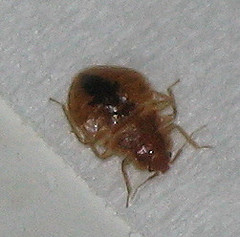Bed bugs are a nasty fact of life that everyone is aware of, but no one likes to deal with. Here’s another nasty information: you may be living with them and you don’t even know it.
Many people are affected by bed bugs, but they just don’t recognize the signs. This is perfectly understandable, as bed bugs are among those nuisances that were all but exterminated during the widespread use of DDT in the United States after World War I.
There are several reasons that bed bugs have become a recurring problem, as well as increased travel to and from other parts of the world. The average person won’t detect that there is a problem until they become plagued with excessive itching and oval-shaped insect bite marks. Even then, these bites are often mistaken for dust mite or mosquito bites.
When the average homemaker finds a problem with bed bugs, he or she will react by spraying commercial pesticides on surface areas. This is not an effective treatment, as bed bugs are extremely talented at hiding away in furniture, mattresses, bedding, and sofa upholstery. Another common mistake is using insect sprays that are formulated to kill mosquitoes or cockroaches. This kind of insect spray does not kill bed bugs and therefore, the upholstery and furniture remains infested.
Indications of Bed Bug Infestation
One of the initial signs of a bed bug infestation is not something that you can see, but rather something you’ll smell. A heavily infested home will have a musty, sweet scent. This odor is emitted through the sweat glands of bed bugs and can be quite offensive.
If you find tiny reddish-brown spots in or around your bed, it may be excrement. Crevices, cracks and holes in and around the bed should be inspected for these stains, including wallpaper, bedsprings and clothing in your dresser. Other telltale indications include egg casings and bits of skin that have been shed by bed bug nymphs. Your living room couch should also be checked for these stains, especially if you or any member of your family has experienced bed bug signs such as swollen bites. Any area in your home where a person stays for more than 30 minutes should be inspected for signs of bed bugs.
Bed Bug Hiding Spots
Any tiny hole, thin crack or even a mattress seam is the ideal spot for a bed bug to hide. These creatures need to be close to human blood, their primary food source, so any opening near the bed or around the living room and bedroom are the primary living spots for bed bugs.
If you find a bed bug in any location of your house, chances are pretty good that the other areas have been affected as well.
Revealing Bed Bugs
Inspect your entire house the instance you detect a bed bug. Take the bed apart and examine every seam of your mattress. Check the foundation and headboard. If you find excrement, insects or bits of insect skin, your home is likely infested with bed bugs.
When bed bugs have been detected, you’ll need to dig a bit deeper to uncover more insects. Bed bugs can and will produce colonies under wallpaper, so be prepared to strip the paper. Wood furniture and upholstered should also be inspected, as bed bugs prefer the porous surface of wood and cloth to plastic and metal, which offer little in the way of cozy nesting places.
Empty the contents of your nightstand, and check it inside and out. Tip it over to inspect the crevices, cracks, recesses and corners of the woodwork underneath. Generally, bed bugs love wood, so there is a good chance that they are hiding in there.
Bed Bug Information
Remember the following information about bed bugs. With this information in mind, you’ll be able to determine whether the pests in your home are bed bugs, or another form of insect.
* Bed bugs are oval-shaped and flat, so they’re able to hide in extremely thin cracks. That’s why their living and breeding sites are so difficult to find.
* Bed bugs nourish by piercing human skin with two elongated beaks. One beak injects saliva that includes both an anesthetic to reduce pain to pierced skin, and an anticoagulant to keep the blood from clotting. The other beak just sucks the blood.
* These nocturnal insects are very lively during the night, especially about an hour before the dawn breaks.
* An adult bed bug can survive for eighteen months or longer without feeding. They are able to stay in their breeding or hiding places until another host comes along to satiate their need for blood.
* Bed bugs are often named “the hitchhikers”. They will travel long distances by riding on suitcases and in clothing and luggage.
* A female bed bug will lay about 300 eggs, and the eggs hatch into nymphs after 10 days. This is why an infestation can take place so rapidly.
If you’ve had a concern with itchy skin or unexplained insect bites, make a careful inspection of your home. Should you find any of the signs of bed bugs, call a professional exterminator quickly.
Tagged with: bed bugs control • pests control
Filed under: Bed Bugs
